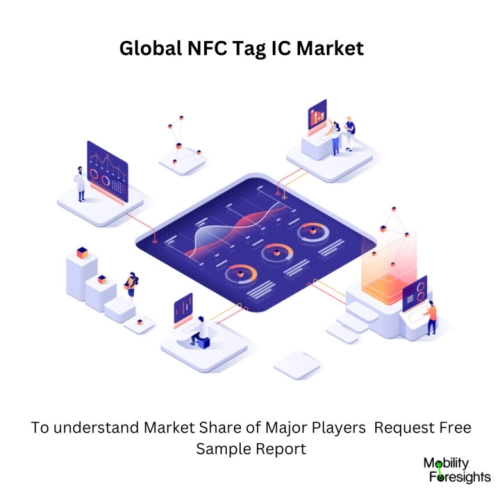
- Get in Touch with Us

Last Updated: Apr 25, 2025 | Study Period: 2023-2030
The electromagnetic induction theory underlies the operation of NFC tag ICs. An NFC tag's antenna develops a current when an NFC-enabled device, such as a smartphone or NFC reader, is brought close to it. The tag's microprocessor is powered by this current, enabling it to send data back to the NFC-enabled device.
NFC tags are fuelled by the energy they receive from the external NFC reader or device; they do not need an internal power source.NFC tag ICs have been widely adopted in a variety of fields and uses, including: Contactless Payments: By using NFC tags in mobile payment systems, customers can make purchases by tapping their cellphones or credit cards on NFC-enabled payment terminals.
Access Control and Identification: NFC tags are used in security systems to control access, enabling users to open doors or gates using their NFC-enabled cards or smartphones. Product authentication: By using NFC tags to check a product's legitimacy, buyers can learn more about the product's production process and place of origin.
Smart Retail: NFC tags on product packaging can give consumers access to extra product details, exclusive deals, or links to online resources. Smart medical equipment can be configured with NFC tags for patient identification, drug administration, and monitoring.

The Global NFC tag IC market accounted for $XX Billion in 2022 and is anticipated to reach $XX Billion by 2030, registering a CAGR of XX% from 2023 to 2030.
The ST25TN512 and ST25TN01K NFC Forum Type 2 tag ICs launched from STMicroelectronics offer a new mix of price and performance for high-volume use cases like trademark protection, consumer interaction, and product information.
The ST25TN512/01K NFC tag ICs support multiple user-protection and privacy mechanisms, including a 7-byte unique chip-identifier code, TruST25 digital signature, NFC Forum T2T permanent write locks at block level, and a configurable kill mode that permanently deactivates the tag.
They are also suitable for smart-city applications and access control. The ST25TN512 and ST25TN01K, which utilize ISO 14443 standards and are certified to NFC Forum Type 2 specifications, can be utilized with NFC-compatible mobile devices or a specialized short-range reader.
| Sl no | Topic |
| 1 | Market Segmentation |
| 2 | Scope of the report |
| 3 | Abbreviations |
| 4 | Research Methodology |
| 5 | Executive Summary |
| 6 | Introduction |
| 7 | Insights from Industry stakeholders |
| 8 | Cost breakdown of Product by sub-components and average profit margin |
| 9 | Disruptive innovation in the Industry |
| 10 | Technology trends in the Industry |
| 11 | Consumer trends in the industry |
| 12 | Recent Production Milestones |
| 13 | Component Manufacturing in US, EU and China |
| 14 | COVID-19 impact on overall market |
| 15 | COVID-19 impact on Production of components |
| 16 | COVID-19 impact on Point of sale |
| 17 | Market Segmentation, Dynamics and Forecast by Geography, 2023-2030 |
| 18 | Market Segmentation, Dynamics and Forecast by Product Type, 2023-2030 |
| 19 | Market Segmentation, Dynamics and Forecast by Application, 2023-2030 |
| 20 | Market Segmentation, Dynamics and Forecast by End use, 2023-2030 |
| 21 | Product installation rate by OEM, 2023 |
| 22 | Incline/Decline in Average B-2-B selling price in past 5 years |
| 23 | Competition from substitute products |
| 24 | Gross margin and average profitability of suppliers |
| 25 | New product development in past 12 months |
| 26 | M&A in past 12 months |
| 27 | Growth strategy of leading players |
| 28 | Market share of vendors, 2023 |
| 29 | Company Profiles |
| 30 | Unmet needs and opportunity for new suppliers |
| 31 | Conclusion |
| 32 | Appendix |